338 Lapua vs 30-06: When You Need to Go Long Distance
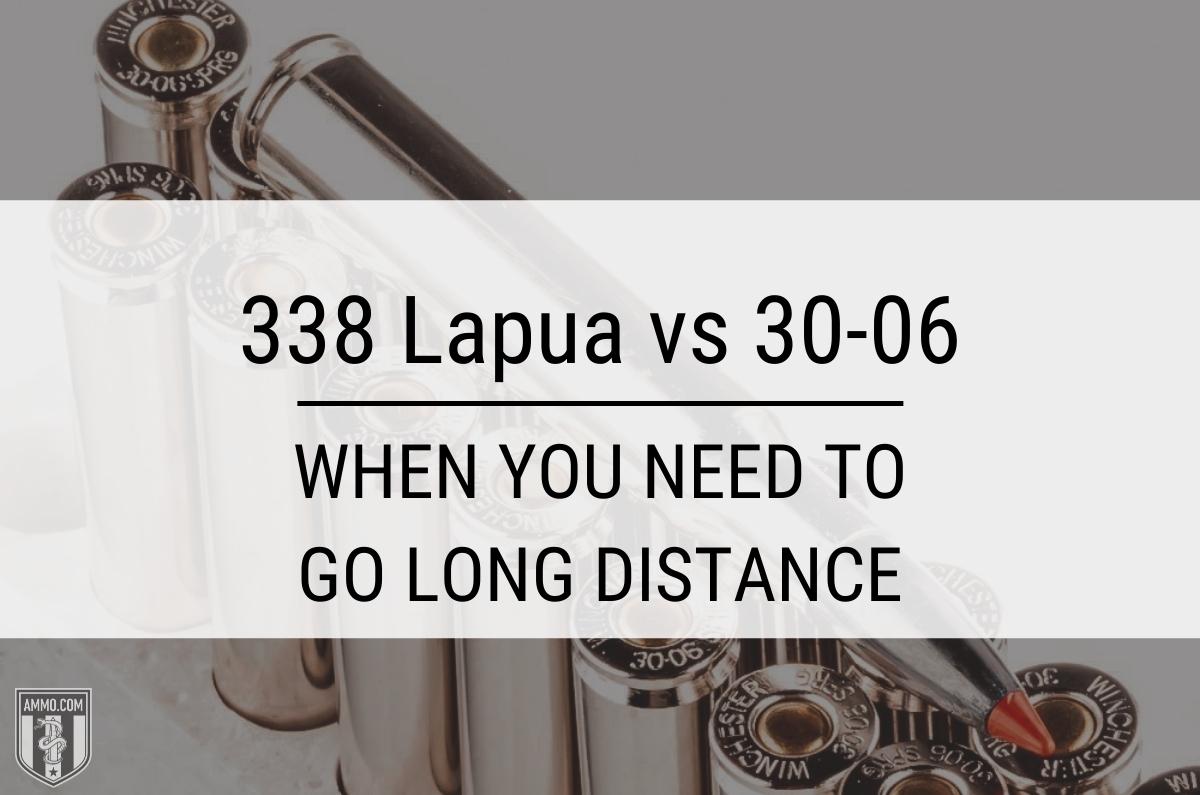 When it comes to long-range shooting, the 338 Lapua Magnum is the rifle cartridge that US military snipers reach for when they need to air it out past 1,000 yards. Currently holding the #3 and #10 positions on the ten longest sniper rifle shots in history, the 338 Lapua Mag is an extremely effective anti-personnel round that has an effective range just short of a mile.
When it comes to long-range shooting, the 338 Lapua Magnum is the rifle cartridge that US military snipers reach for when they need to air it out past 1,000 yards. Currently holding the #3 and #10 positions on the ten longest sniper rifle shots in history, the 338 Lapua Mag is an extremely effective anti-personnel round that has an effective range just short of a mile.
If there is one rifle cartridge that defined warfare and hunting in the 20th Century, it is unquestionably the 30-06 Springfield. The 30-06 was carried by US soldiers from World War I through Korea and saw limited use in Vietnam. After the 30-06 received its DD-214, it spent retirement in the woods as one of the most popular sporting cartridges in North America. The 338 Lapua Mag and 30-06 simply do not compare as they live in two different categories of shooting. The 338 Lapua outperforms the 30-06 in every ballistic category.
However, I’ve heard some chatter among hunters that they’re considering adding a 338 Lapua for extra-large or dangerous game hunts. So, let’s compare the warhorse 30-06 to the 338 Lapua Magnum.
Understanding The Difference Between 338 Lapua vs 30-06
The 338 Lapua Magnum was developed in the late 1980s as a long-range sniping round to bridge the gap between 300 Winchester Magnum and the 50 BMG. In comparison, the 30-06 Springfield was developed in the early 1900s as the new standard issue rifle cartridge for the U.S. military to combat the ballistically superior 7mm Mauser round.
To put this into perspective, the 30-06 was 83 years old when the 338 Lapua was accepted as a NATO cartridge in 1989. Essentially what we are dealing with here is nothing short of a rifle cartridge generational gap.
The 338 Lapua is superior in all ballistic categories, yet the 30-06 remains extremely popular in the big game hunting community. Let’s explore why.
Cartridge Specs
The most striking difference between the 338 Lapua and 30-06 is case capacity. The 30-06 can hold 68 gr of propellant while the 338 Lapua has a cavernous capacity of 114 gr (a 67% increase).
This massively increased case capacity is needed to push the 0.338” diameter bullets fired by the 338 Lapua at nearly 3,000 FPS and 4800 ft-lbs of muzzle energy.
One thing I wanted to note was the Max Pressure category as you’ll note the max pressure for 338 is listed as N/A.
At the time of writing, SAAMI has not proofed the 338 Lapua and does not have an established max pressure for the round. To complicate matters, Lapua and the CIP have been somewhat ambivalent about the max pressure for the cartridge.
There is some scholarly debate as to the max pressure for the 338 Lapua, but the lower limits (and therefore safer) suggest 420 MPa (60,916 PSI).
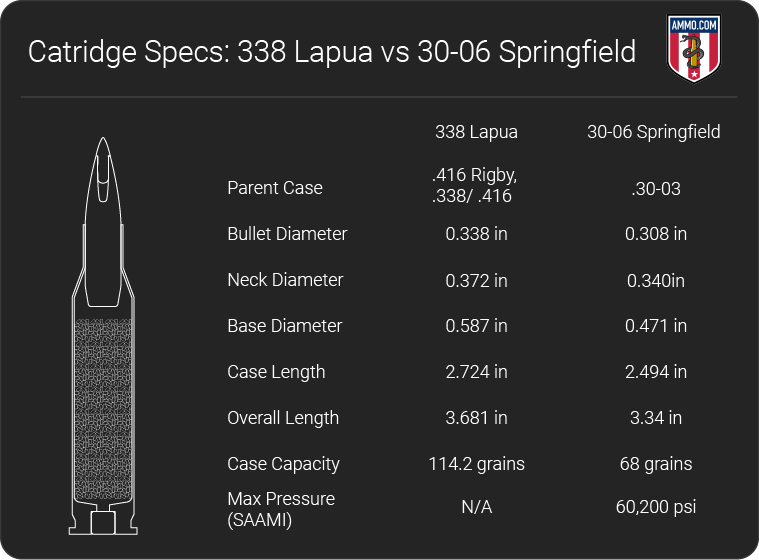
Speaking of pressure, I feel like my shoulder could use a massage after popping off a few 338 rounds, let’s talk recoil next!
Recoil
The 338 Lapua will be superior in almost every category, but recoil is not one of them. On average, the 30-06 will generate 25 foot-pounds of recoil energy while the 338 will slap your shoulder with 40 ft-lbs force (a 60% increase).
All of that case capacity and a 250 grain bullet come back to punish you when it comes to recoil for the 338. And I can say from experience, 40 ft-lbs is shoulder bruising territory.
After a full shooting session of absorbing all that savage recoil from a 338, I’d challenge any non-military trained sniper to maintain their trigger discipline. Recoil anticipation and the resulting trigger jerk are real issues when shooting a magnum cartridge of this magnitude.
Felt recoil can be tamed somewhat with proper shooting form, a muzzle brake, and reduced power handloads, but it cannot be eliminated.
Even with these modifications/techniques, the 30-06 will still have less recoil.
Trajectory
Trajectory is how we quantify a bullet’s flight path as it travels downrange measured in inches of bullet drop.
The increased case capacity afforded by the massive 338 Lapua cartridge case allows for a higher muzzle velocity and flatter trajectory. At 400 yards, a 250gr match 338 has dropped -18.8” while the 180gr match 30-06 has experienced -21.9” of bullet drop.
Now, this might not seem like a lot, but the further out you go the more pronounced the difference becomes. To simulate this, you’ll need to utilize a ballistic calculator.
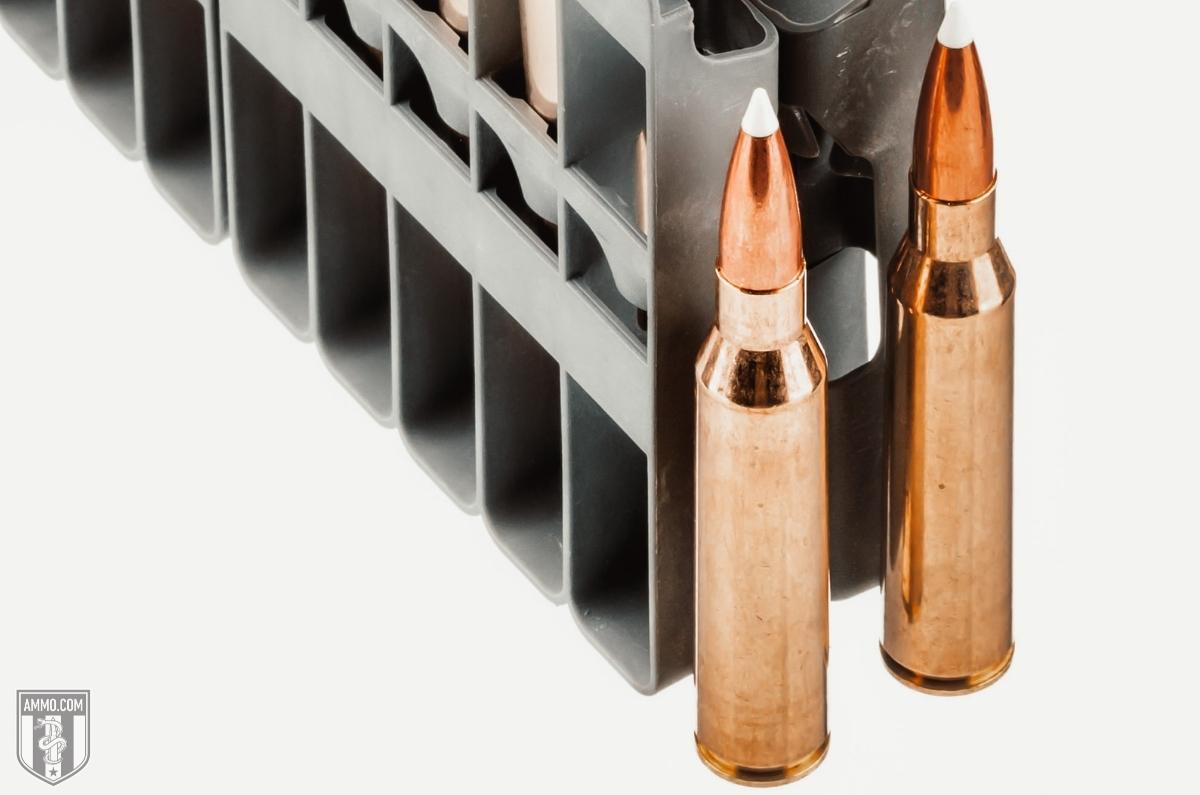
At 1,000 yards, the 30-06 has dropped -398” and is approaching subsonic velocities, while the 338 is still well above supersonic speeds and has dropped -288” (a little over 9 feet less).
These results clearly show how the 338 is ideally designed with long-range shooting in mind.
Accuracy
Accuracy is difficult to measure as the shooting platform, consistency of ammo, skill of the shooter, and environmental conditions all play a part.
All things being equal, both the 30-06 and the 338 Lapua are extremely accurate within their effective ranges and MOA level accuracy is achievable with match-grade ammo, quality optics, and proper execution of the fundamentals of marksmanship.
However, if you want to qualify accuracy, we need to separate this section into two subsections: under 1000 yards and over 1000 yards.
For the 30-06, 1,000 yards is pushing the effective limits of the cartridge. To make it out to 1000 yards with a 30-06, you’ll need a well-tuned precision rifle and match-grade handloads tailored to that rifle.
By comparison, the 338 Lapua Magnum is just stretching its legs at 1000 yards and leisurely waves at the yardage marker as it screams by.
The average supersonic limit for .338 Lapua is approximately 1500 yards, a full 50% more than the 30-06.
Here’s how the accuracy breaks down, under 1000 yards accuracy should be similar between the two cartridges. However, I would give a slight edge to the 30-06 as it has less recoil, allowing the shooter to focus on trigger control and marksmanship.
Over 1000 yards, the 338 Lapua Magnum is clearly superior as it can maintain supersonic flight out to 1500+ yards.
Ballistic Coefficient

Ballistic coefficient (BC) is a measure of how well a bullet resists wind and air resistance. Put another way, it’s a numeric representation of how aerodynamic a bullet is. A high BC is preferred as this means the bullet will buck the wind easier.
Generally, a heavier bullet will have a higher BC as it takes more force to disrupt the flight of a heavier bullet than a lighter one.
With that in mind, it should not be a big surprise to you that the 338 Lapua generally has a higher BC than the 30-06, and this was done by design.
On average the 338 Lapua has a BC around 0.62 while the 30-06 measures about 0.43. Anything above 0.4 is considered a good BC, what this tells us is that both the 338 and 30-06 are excellent at resisting wind drift, but the 338 just does it better.
Sectional Density
Sectional Density (SD) is the measure of how well a bullet penetrates a target. This is extremely important when hunting big game, as you need a bullet that can punch through thick hide, bone, and sinew.
Sectional density is calculated by comparing the bullet weight and the bullet diameter. The higher the SD the deeper the bullet will penetrate the target.
Both the 30-06 and 338 have excellent SD results, however, the 338 has an average SD of 0.34 compared to 0.26 for 30-06. As the 338 Lapua fires a heavier bullet and is designed to penetrate body armor at longer ranges, it’s not surprising that it has a higher SD than 30-06.
Hunting
For North America, the 30-06 is the better choice for your hunting rifle. However, the 338 Lapua is the better choice for an African safari if you’re planning on hunting extra-large game animals.
One of the huge assets of the 30-06 is its versatility in bullet weights. With its wider range of grain weights to choose from, the 30-06 offers shooters the versatility to take down varmints and bears alike.

With bullet designs like the Nosler Partition, Barnes TSX, and Norma TIPSTRIKE, there is not a game animal in North America that the 30-06 cannot takedown. I wouldn’t recommend a 30-06 for hunting Kodiak bear or grizzly, but it can and has been done.
However, the main reason for selecting the 30-06 over the 338 for North American game is that the effective range of the 30-06 is more than sufficient. Although the 338 can shoot further, it’s extremely rare that any ethical hunter would ever take a shot past 500 yards. And even at that distance, the 30-06 still has enough kinetic energy to take down a whitetail (1000 ft-lbs).
Furthermore, as the 30-06 has less felt recoil, shot placement will typically be better, especially at longer ranges, as shooters can focus on a clean trigger squeeze and proper sight alignment without the fear of punishing recoil.
Can the 338 be used for North American game? Absolutely. But using a 338 Lapua for sniping whitetail feels somewhat like hauling out a Barret M107A1 to the woods to go rabbit hunting. It’s overkill, and with the price of ammo right now, the 30-06 or even the 300 Win Mag, 308 Winchester, or 6.5 Creedmoor are more than enough for your North American hunting needs.
In terms of African game, the 30-06 can be used for smaller animals like gazelle, warthog, Kudu, and Eland. However, if you want to hunt the African Big 5, you’ll need something with more stopping power and sectional density like the 338.
The 338 Lapua Mag can take down every large game animal on the planet, including African elephants, cape buffalo, and rhinoceros with proper shot placement. And just in case, I’d recommend bringing along a heavier caliber backup like a 416 Weatherby Magnum.
Ammo and Rifle Cost/Availability
When considering a new bolt action rifle, the cost is a consideration for most shooters. For hunting rifles, 30-06 is going to be the better choice in terms of budget.
Virtually every rifle manufacturer has an offering in 30-06 as it has established itself as the premier sporting cartridge in North America.
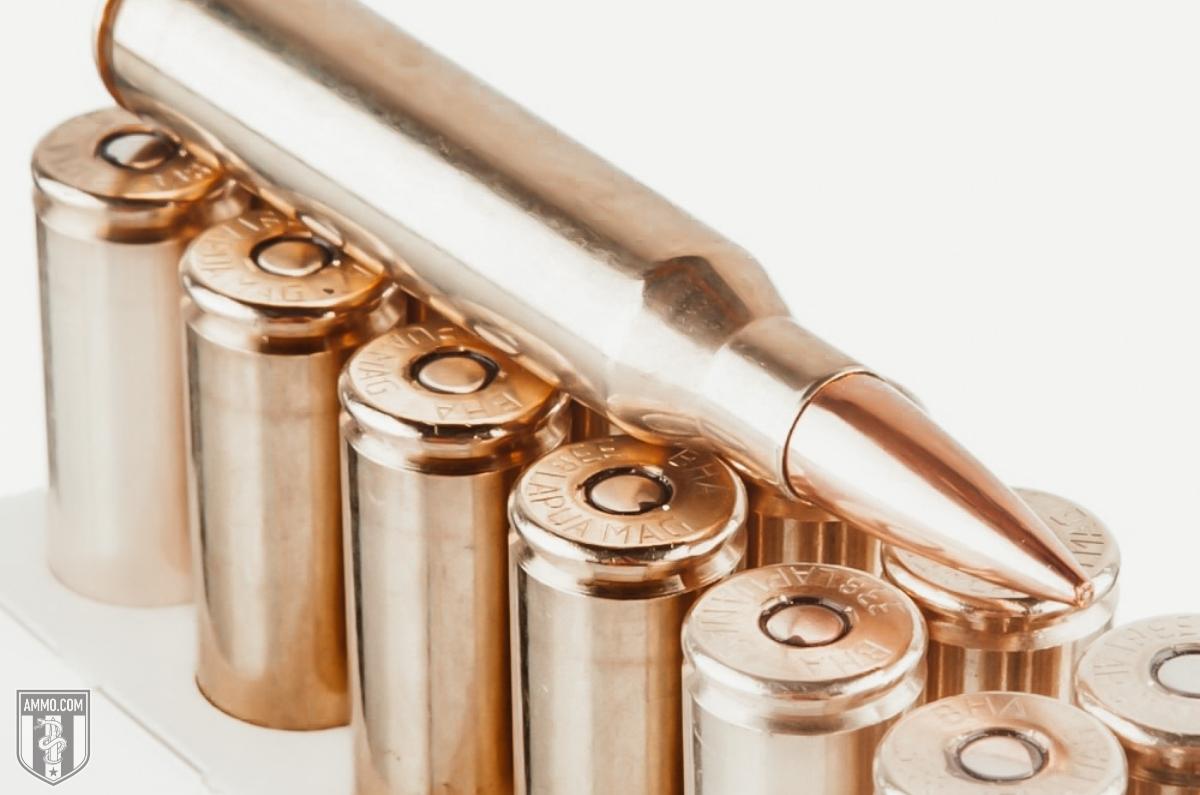
Popular 30-06 hunting rifles include:
- Remington 700
- Savage 110 Hunter
- Ruger Hawkeye
- Winchester Model 70
All the above rifles can be had for under $900 new in the box at current pricing. Several manufacturers offer budget rifle options for 30-06 as well, such as the Savage Axis and Ruger American rifle lines that can be had for under $700.
For a 338 Lapua Magnum, you need to be ready to drop some serious coin on a new rifle as there are fewer options available. The terms “budget” and “338 Lapua” typically do not live in the same sentence.
Remington, Savage, and Ruger still have options available in 338 Lapua, but do not expect to drop anything less than a grand on a 338 Lapua bolt action rifle.
If you like long-distance target shooting and are looking for a modern precision rifle, they can be had for 338 but are not typically available for 30-06. Just make sure that you have deep pockets as a Sako TRG, Barrett MRAD, or Accuracy International AXMC is going to run you no less than $4,000 or more for the rifle alone.
This massive cost discrepancy is seen for ammo as well.
The 30-06 is by far the better choice when it comes to ammo cost. At the time of writing, you can easily acquire 30-06 fmj practice ammo for around $1/round and premium hunting ammo can be had for about $2/round.
This is not the case when it comes to 338 Lapua Magnum. If you’re planning on shooting 338, I do hope that you have a sizable ammo budget because you’re going to need it!
The absolute cheapest 338 Lapua fmj practice ammo that I could find on the Internet was checking in at about $4.45/round (and you had to buy a 200 round case to get this reduced price). Now let’s consider a 50 round practice session at the range. Shooting 30-06, will only cost you about $50 in ammo as compared to $220 for shooting 338 Lapua Mag.
That’s a 4x difference!

And it only gets worse when you get into premium 338 Lapua hunting ammo, this will on average run you no less than $8/round with match-grade options in the $10/round realm. Furthermore, there are considerably more ammo options for 30-06 than 338 Lapua as the 30-06 has been on the market for over a century.
As the 338 Lapua Mag is mostly seen as a round for military snipers, innovations are focused on that type of shooting, there are fewer options available for hunting as fewer hunters use the round.
30-06 is clearly the better option for ammo availability and overall cost.
Reloading
Handloading is one way to get your cost per round down to levels that won’t keep you awake at night, especially for 338 Lapua. Reloading also allows you to produce your own customized ammo that is tuned to your precision rifle. You can squeeze out every potential FPS and adjust your cartridge shoulders to achieve the pinnacle of downrange accuracy.
Although handloading does require some initial investment in equipment (presses, dies, manuals, and reloading components), it will easily pay for itself when loading a magnum cartridge such as the 338.
When reloading for 30-06, you have a wealth of knowledge at your fingertips as handloaders have been working on optimizing the 30-06 for decades. Bullet manufacturers like Hornady, Nosler, Sierra, Barnes, and Norma are more than happy to stock .308” bullets as they are incredibly popular. Reloading for 30-06 also allows you to stockpile components as 30-caliber bullets are also used in 308 Winchester, 300 Winchester Magnum, 300 PRC, and 300 WSM (just to name a few).
Handloading for 338 Lapua Mag is a necessity if you plan on shooting long-distance competitions or enjoy firing more than a few rounds per month. With the outlandish price of factory 338 ammo, reloading can significantly reduce your overall cost per range session.
The only downside to handloading for the 338 is that there are fewer cross-compatible cartridges that fire a .338” bullet. Some .338 caliber cartridges include 338 Federal, 338 Win Mag, 338 Rem Ultra Mag, and 340 Weatherby Magnum.
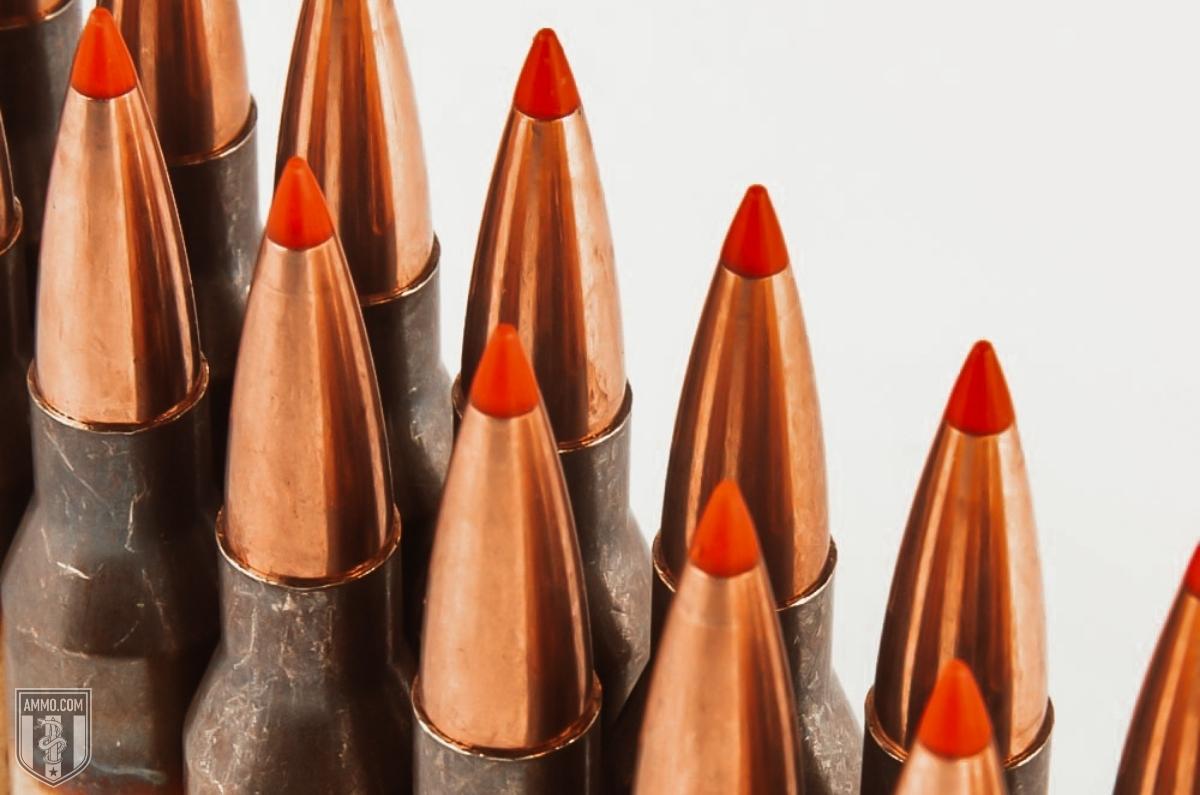
Ballistics
Our team here at Ammo.com has scoured the internet to provide you with in-depth ballistics tables for the 338 Lapua Mag and the 30-06 Springfield. These tables will compare popular grain weight bullets to muzzle velocity, muzzle energy, and bullet drop out to 400 yards. If you need longer range ballistics, we recommend using a ballistic calculator as most manufacturers do not publish this data.
338 Lapua Ballistics
Note: This information comes from the manufacturer and is for informational purposes only. The actual ballistics obtained with your firearm can vary considerably from the advertised ballistics. Also, ballistics can vary from lot to lot with the same brand and type load.
| 338 Lapua Magnum Bullet WEIGHT | Muzzle VELOCITY (fps) | Muzzle ENERGY (ft. lbs.) | TRAJECTORY (in.) | |||||||||||
|---|---|---|---|---|---|---|---|---|---|---|---|---|---|---|
| Muzzle | 100 yds. | 200 yds. | 300 yds. | 400 yds. | Muzzle | 100 yds. | 200 yds. | 300 yds. | 400 yds. | 100 yds. | 200 yds. | 300 yds. | 400 yds. | |
| 250 Grain | 2900 | 2685 | 2481 | 2285 | 2098 | 4668 | 4002 | 2416 | 2899 | 2444 | 1.7 | 0 | -7.3 | -21.3 |
| 250 Grain | 2963 | 2795 | 2640 | 2493 | n/a | 4842 | 4341 | 3881 | 3458 | n/a | 1.9 | 0 | -7.9 | 0 |
| 250 Grain Match | 2900 | 2760 | 2625 | 2494 | 2366 | 4668 | 4229 | 3825 | 3452 | 3108 | 1.5 | 0 | -6.6 | -18.8 |
| 285 Grain | 2745 | 2616 | 2491 | 2369 | 2251 | 4768 | 4331 | 3926 | 3552 | 3206 | 1.8 | 0 | -7.4 | -21 |
| 285 Grain Match | 2745 | 2623 | 2504 | 2388 | 2275 | 4768 | 4352 | 3966 | 3608 | 3275 | 1.8 | 0 | -7.3 | -20.8 |
| 300 Grain | 2660 | 2544 | 2432 | 2322 | n/a | 4715 | 4313 | 3940 | 3592 | n/a | 1.9 | 0 | -7.8 | n/a |
.30-06 Ballistics
Note: This information comes from the manufacturer and is for informational purposes only. The actual ballistics obtained with your firearm can vary considerably from the advertised ballistics. Also, ballistics can vary from lot to lot with the same brand and type load.
| 30-06 Bullet WEIGHT | Muzzle VELOCITY (fps) | Muzzle ENERGY (ft. lbs.) | TRAJECTORY (in.) | |||||||||||
|---|---|---|---|---|---|---|---|---|---|---|---|---|---|---|
| Muzzle | 100 yds. | 200 yds. | 300 yds. | 400 yds. | Muzzle | 100 yds. | 200 yds. | 300 yds. | 400 yds. | 100 yds. | 200 yds. | 300 yds. | 400 yds. | |
| 55 Grain | 4080 | 3485 | 2965 | 2502 | 2083 | 2033 | 1483 | 1074 | 764 | 530 | 2 | 1.9 | -2.1 | -11.7 |
| 125 Grain | 2660 | 2335 | 2034 | 1757 | n/a | 1964 | 1513 | 1148 | 856 | n/a | 0 | -5.2 | -18.9 | 0 |
| 125 Grain | 2700 | 2412 | 2143 | 1891 | 1660 | 2023 | 1615 | 1274 | 993 | 765 | 2.3 | 0 | -9.9 | -29.5 |
| 125 Grain | 3140 | 2780 | 2447 | 2138 | 1853 | 2736 | 2145 | 1662 | 1279 | 953 | 2 | 1 | -6.2 | -21 |
| 150 Grain | 2910 | 2617 | 2342 | 2083 | 1853 | 2820 | 2281 | 1827 | 1445 | 1135 | 2.5 | 0.8 | -7.2 | -23.4 |
| 150 Grain | 3080 | 2848 | 2617 | 2417 | 2216 | 3159 | 2700 | 2298 | 1945 | 1636 | 1.4 | 0 | -6.4 | -18.9 |
| 165 Grain | 2800 | 2534 | 2283 | 2047 | 1825 | 2872 | 2352 | 1909 | 1534 | 1220 | 2.5 | 0.4 | -8.4 | -25.5 |
| 168 Grain | 2710 | 2522 | 2346 | 2169 | 2003 | 2739 | 2372 | 2045 | 1754 | 1497 | 2.5 | 0.4 | -8 | -23.5 |
| 168 Grain M1 Garand | 2710 | 2523 | 2343 | 2171 | 2006 | 2739 | 2374 | 2048 | 1758 | 1501 | 2.3 | 0 | -8.6 | -24.6 |
| 170 Grain | 2000 | 1740 | 1510 | n/a | n/a | 1510 | 1145 | 860 | n/a | n/a | 0 | 0 | 0 | 0 |
| 178 Grain | 2720 | 2511 | 2311 | 2121 | 1939 | 2924 | 2491 | 2111 | 1777 | 1486 | 2.5 | 0.4 | -8.2 | -24.6 |
| 180 Grain | 2700 | 2469 | 2250 | 2042 | 1846 | 2913 | 2436 | 2023 | 1666 | 1362 | -2.5 | 0 | -9.3 | -27 |
| 180 Grain Superformance | 2820 | 2630 | 2447 | 2272 | 2104 | 3178 | 2764 | 2393 | 2063 | 1769 | 1.8 | 0 | -7.6 | -21.9 |
| 180 Grain High Energy | 2880 | 2690 | 2500 | 2320 | 2150 | 3315 | 2880 | 2495 | 2150 | 1845 | 1.7 | 0 | -7.2 | -21 |
| 220 Grain | 2410 | 2130 | 1870 | 1632 | 1422 | 2837 | 2216 | 1708 | 1301 | 988 | 2.5 | -1.7 | -18 | 0 |
A History of the 338 Lapua Magnum: The 50 BMG Lite
Development of the 338 Lapua Mag began in 1983 by a US-based company, Research Armament Industries (RAI). Their goal was to create a cartridge that bridged the gap between the 308 Winchester/300 Win Mag and the 50 BMG.
The design specification required that the cartridge be able to penetrate 5 layers of military-grade body armor at 1000 meters and fire a 0.338” diameter bullet for its ideal sectional density and ballistic coefficient. The targeted muzzle velocity to meet these goals was 3,000 fps.
Initial designs for the 338 Lapua Magnum utilized the 416 Rigby as a parent case, simply necking it down to accept a 250 grain Hornady A-MAX bullet. Sadly, the 416 Rigby case was not strong enough to withstand the pressures needed to achieve RAI’s ballistic goals.
By 1984, RAI was under pressure from the military to finish their work and in desperation, they reached out to the Finnish ammo company, Lapua, for assistance. Straddled with debt, RAI had to drop out of the program and this left the fate of the new cartridge in the hands of the engineers at Lapua.
The ballistics team at Lapua joined forces with Sako and Accuracy International to work on redesigning the 416/338 case so that it could handle 60,000 psi of pressure.
The final case design was an extremely pressure-resistant that was able to achieve velocities just short of the initial 3,000 fps goal. The decision was also made to depart from Hornady bullets, utilizing a new bullet design instead, the LockBase B408 FMJ.

The finalized 338 Lapua Magnum cartridge was submitted and accepted by the CIP (the European version of SAAMI) in 1989 and became a NATO cartridge shortly thereafter. NATO standard 338 Lapua Mag ammo fires a 250 grain bullet with a muzzle velocity of 3000 fps and muzzle energy of 4892 ft-lbs.
Precision rifle shooters who like to air it out to 1000 yards or more will appreciate the 338’s ability to easily remain supersonic past 1400 yards and maintain MOA levels of accuracy. While the 338 Lapua has a trajectory that would make any 6.5 Creedmoor or 300 Win Mag shooter green with.
The 338 Lapua Mag is a powerhouse round and will be competing with the 50 BMG for years to come. Plus, if elk ever start wearing body armor, you are covered with a .338!
A History of the 30-06 Springfield: America's Rifle Cartridge
Around 1901, the U.S. Military started developing a new cartridge to replace the outdated 30-40 Krag. After the Spanish-American War in Cuba, it was clear that the 30-40 Krag was an inferior design compared to the 7x57mm Mauser and the US military did not want to fall behind with advancements in bolt action rifle and cartridge technology.
At the time, heavier bullet weights were thought to be the superior ballistic choice. Therefore, the initial design submitted in 1903 used the same 220-grain round nose bullets fired by the 30-40 Krag.
However, it didn’t take long for the American generals to take note that multiple European nations were favoring higher velocity, Spitzer (pointed) projectiles in their new bolt action rifles. Not wanting to get left behind, the U.S. Military was quick to adopt a similar design, and in 1906 a new cartridge was submitted that fired a Spitzer flat-based 150 grain bullet. The original design for 30-06 Springfield achieved a muzzle velocity of 2,700 fps, packed 2,429 ft-lbs of muzzle energy.
And thus the 30-06 Springfield was born. The “30” designates the bullet caliber and the “06” (pronounced: aught six) designates the year of its adoption. The 30-06 Springfield can also be referred to as the 3006 Springfield or just simply as 30-06.
Not only has the 30-06 seen massive success on the battlefield, but it has also seen immense commercial success in the civilian market. Big game hunters loved the amazing terminal ballistics and long-range that the 30-06 offered while having a recoil impulse that is not punishing to the shoulder.
Since its introduction to the civilian market, the 30-06 has been the de facto hunting cartridge that all other hunting caliber cartridges are measured against. The most popular loadings for 30-06 range between 150 and 180 gr bullet weights with the 180 grain bullet being the most popular with big game hunters. However, specialty ammo can go as low as 110-grain bullets and as high as 220 grain projectiles.
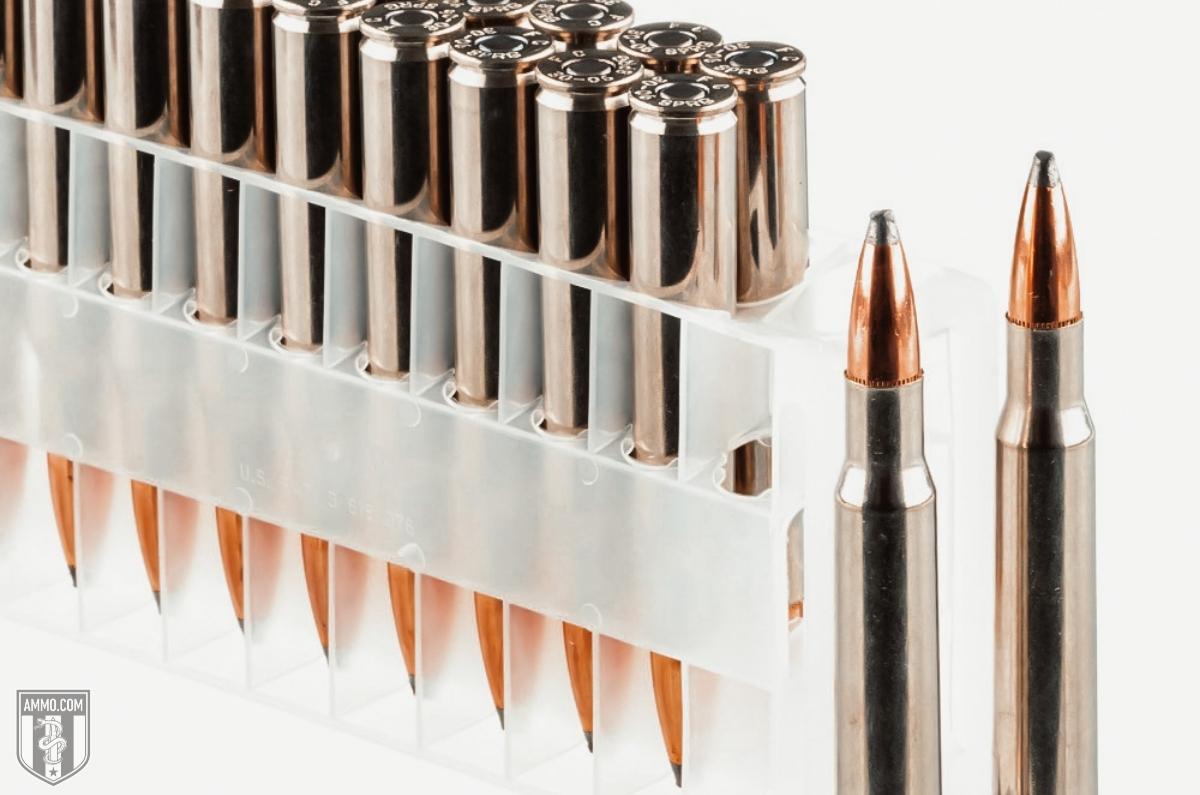
Final Shots: 338 Lapua vs 30-06
The 338 Lapua Magnum is a cartridge that was specifically designed for military sniper rifles like the Barrett MRAD and Accuracy International L11583. It is a massive, punishing, long-distance sniping round that can punch through military-grade body armor at 1,000 yards and remain combat effective well past 1,500 yards. The 338 has an incredibly flat trajectory but at the cost of extremely high recoil that is difficult to control for the novice shooter.
The 30-06 Springfield is a rifle cartridge that simply transcends time. It has been baptized by fire in both World Wars and a force to be reckoned with on medium to large game in the woods. Though many advancements have been made in sporting cartridges, the 30-06 remains one of the most popular bolt action rifle chamberings across North America.
But the question remains, do you really need a 338 Lapua Magnum in your collection? One argument is for the 338 is long-range shooting competitions. Shooters suggest that the flatter trajectory might give you an advantage over the competition. However, you will rarely see a 338 Lapua on the 1,000-yard line in competition as other calibers can get you to that range with less recoil and lower cost per round, such as the 300 Win Mag, 6.5 Creedmoor, and the new 300 PRC.
What about dangerous and extremely large African game? Yes, the 338 can get the job done on these hunts, but most African hunters will opt for something a little bigger to create a larger permanent wound channel like a 375 H&H Magnum, 416 Rigby, or a 458 Lott.
So, does the average shooter really need a 338 Lapua? No, the 30-06 can do everything you need at one quarter the cost.
But...
If you WANT a 338 and have the money to feed it, then I say go for it! Because sometimes happiness is MORE important than practicality. Life is short, so do the things that make you happy. And if that means getting your shoulder walloped by a 338 Lapua Magnum, then squeeze the trigger, my fellow shooters!
Ammo Comparisons
- .308 vs 5.56
- 6.5 Creedmoor vs .308
- .300 Blackout vs .308
- .300 Win Mag vs .308
- .243 vs .308
- .308 vs .30-06
- 7mm-08 vs .308
- .270 vs .308
- 7.62x39 vs .308
- .223 vs .308
- .338 Lapua vs .308
- .380 ACP vs 9mm
- .223 vs 5.56
- .300 Blackout vs 5.56
- 9mm vs 45 ACP
- 9mm vs 40 S&W
- .357 SIG vs 9mm
- 10mm vs 9mm
- 9mm vs 9mm Luger
- .243 vs .270
- .300 Win Mag vs .30-06
- .270 vs .30-06
- .40 vs .45
- 38 Special vs 357
- 9mm vs 40 vs 45
- 5.56 vs 7.62x39
- 338 Lapua vs .30-06
- .30-30 vs .30-06
- 300 PRC vs 338 Lapua
- .30-06 vs 7mm
- 300 Win Mag vs 338 Lapua
- 300 PRC vs 300 Win Mag
- 300 WSM vs 300 Win Mag
- 338 Win Mag vs 338 Lapua
- 12 Gauge vs 20 Gauge
- 10mm vs 357 Mag
- .30-30 vs 7.62x39
- 224 Valkyrie vs 22-250
- 17 HMR vs 22 Mag
- 7.62x39 vs .300 Blackout
- 45 ACP vs 45 Auto
- 45-70 vs 30-30
- 300 Blackout vs 223
- 357 Magnum vs 9mm
- 350 Legend vs 300 Blackout
- 224 Valkyrie vs 223
- 45 ACP vs 38 Super
- 6.5 Grendel vs .308
- 17 HMR vs 22 LR
- 10 Gauge vs 12 Gauge
- 22-250 vs 223
- 45 Colt vs 45 ACP
- 350 Legend vs 30-30
- 5.7x28 vs 223
- 5.7 vs 9mm
- 5.56 vs 5.7
- 22 vs 9mm
- Buckshot vs Birdshot
- 450 Bushmaster vs 308
- 450 Bushmaster vs 223
- Buckshot vs Slug
- 6.5 Grendel vs 5.56 vs 223
- 6mm ARC vs 6.5 Grendel
- 44 vs 45
- 458 SOCOM vs 5.56
- 357 vs 44
- 32 ACP vs 380
- 300 Win Mag vs 338 Win Mag vs 338 Lapua Mag
- 450 Bushmaster vs 458 SOCOM vs 50 Beowulf
- 6mm Creedmoor vs 6.5 Creedmoor
- TMJ vs FMJ
- 44 Special Vs 44 Magnum
- 45 90 vs 45 70
- 6.8 Western vs 6.8 SPC
- 50 Beowulf vs 50 BMG
- 26 Nosler vs 6.5 PRC
- 28 Gauge vs 410
- 6.8 SPC vs 5.56
- 6.8 SPC vs 6.5 Grendel
- 6.8 Western vs 7mm Rem Mag vs .28 Nosler
- 6.8 Western vs 6.5 Creedmoor
- 22 Hornet vs 223
- 6.8 Western vs 6.5 PRC
- .410 vs 12 Gauge
- .410 vs 20 Gauge
- 22 LR vs 22 Mag
- 6mm ARC vs 243
- 7mm-08 vs 270
- 243 vs 6.5 Creedmoor
- Nickel vs Brass Casing
- 204 Ruger vs 223
- 50 Beowulf vs 5.56
- 260 Remington vs 6.5 Creedmoor
- 6mm Remington vs 243
- 28 Nosler vs 300 PRC
- 50 Beowulf vs 50 AE
- 22 Nosler vs 22-250
- 450 Marlin vs 45-70
- 300 Win Mag vs 300 Norma
- 458 SOCOM vs 300 Blackout
- 38-55 vs 45-70
- 22 Hornet vs 22 LR
- 300 Norma vs 338 Lapua
- 338 Lapua vs 50 BMG
- 28 Nosler vs 300 Win Mag
- 28 Nosler vs 6.5 Creedmoor
- 204 vs 22-250
- 458 SOCOM vs 45 70
- 44 40 vs 45 70
- 6.8 SPC vs 6.5 Creedmoor
- 450 Bushmaster vs 30-06
- 7mm Rem Mag vs 300 Win Mag
- 30 Carbine vs 223
- 25-06 vs 30-06
- 26 Nosler vs 28 Nosler
- 16ga vs 12ga
- 30 06 vs 7.62 x54R
- 9mm Makarov vs 9mm Luger
- 350 Legend vs 223
- 30 Carbine vs 5.56
- 6.5x55 vs 6.5 Creedmoor
- 6.5 Creedmoor vs 270 vs 25-06
- M193 vs M855
- 450 Bushmaster vs 458 SOCOM
- 6.5 Grendel vs 6.5 Creedmoor
- 350 Legend vs 5.56
- .277 Fury vs 6.8 SPC
- 277 Fury vs 300 Win Mag
- 10mm vs .45 ACP
- 277 Fury vs 223
- 6.8 SPC vs 300 Blackout
- 6.5 PRC vs 6.5 Creedmoor
- 277 Fury vs 308
- 277 Fury vs 6.5 Creedmoor
- 350 Legend vs 450 Bushmaster
- 277 Fury Vs 5.56 NATO
- 10mm vs 40S&W
- 32 ACP vs 9mm
- 32 Special vs 9mm
- 8.6 Blackout vs 300 Blackout
- 30 Super Carry vs. 9mm
- 5.56 vs 9mm
- .50 Action Express vs 9mm
- 7.62x25 vs. 9mm
- 10mm vs 44 Magnum
- 300 Blackout vs 300 Win Mag
- 6.5 Grendel vs 300 Blackout
- 460 Rowland vs 10mm
- 300 RUM vs 300 PRC
- 300 Norma vs 300 PRC
- 45 GAP vs 45 ACP
- 7mm PRC vs 300 Win Mag
- 300 PRC vs 6.5 Creedmoor
- 300 PRC vs 308
- 357 SIG vs 357 Mag
- 7.62x39 vs 7.62x51
- 243 Win vs 223 Rem
- 30 Nosler vs 300 PRC
- 6.5 Creedmoor vs. 30-06 Springfield
- 450 S&W vs. 44 Magnum
- 6.5 Creedmoor vs. 300 Win Mag
- 454 Cassull vs. 45-70 Govt
- 454 Cassull vs. 44 Mag
- 7.62x54r vs. 308 Winchester
- 22 ARC vs. 223 Rem
- Subsonic vs. Supersonic Ammo
